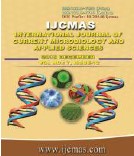


 National Academy of Agricultural Sciences (NAAS)
National Academy of Agricultural Sciences (NAAS)

|
PRINT ISSN : 2319-7692
Online ISSN : 2319-7706 Issues : 12 per year Publisher : Excellent Publishers Email : editorijcmas@gmail.com / submit@ijcmas.com Editor-in-chief: Dr.M.Prakash Index Copernicus ICV 2018: 95.39 NAAS RATING 2020: 5.38 |
Bioremediation is a highly potential approach to restore and rehabilitate oil polluted soils having many recalcitrant polyaromatic hydrocarbons (PAHs) such as dibenzothiophene (DBT), benzothiophene (BT), etc by use of microorganisms. In the present study biosurfactant producing bacterial diversity and distribution for bioremediation of oil contaminated soils of upper Assam for the growth of Muga host plant Som (Persea bombycina) were studied. Crude oil contaminated soil samples were collected from Lakwa, Gelakey, and Nazira regions of upper Assam and heterotrophic bacteria were isolated. Various screening methods for biosurfactant production as well as plant growth promoting properties were characterized for the bacterial isolates. Results of the drop collapse assay indicated the presence of biosurfactant producing bacteria. Emulsification index (EI) of 40 bacterial isolates revealed that L3, L5, L6, N2, N9, N13, N14, G1, G3, G7, G8, G9, G10, G11 isolates had higher biosurfactant production. EI values of these isolates were significantly high (> 35%) indicating potentiality higher biosurfactant production. Blue agar CTAB method was done to characterize the presence of anionic biosurfactants. Screening of PGPR activity was checked by starch hydrolysis, phosphate solubilization and extracellular enzyme screening such as catalase, lipase and cellulose. Among all the isolates, N6, N14, G1, G3, G7, G8, G9 showed good plant growth promoting characters along with biosurfactant producing ability. Heterotrophic biosurfactant producing bacterial diversity has been deciphered by 16S rRNA gene sequencing. Results indicated that abundance of Bacillus sp., Pseudomonas sp., Staphylococcus sp., Enterococcus sp., Klebsiella sp. and Serratia sp. in hydrocarbon contaminated soils.
 |
 |
 |
 |
 |